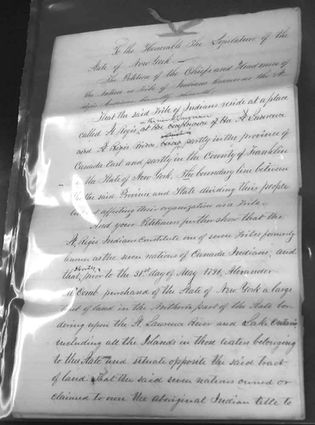Tribe acquires historical document
ST. REGIS MOHAWK TRIBE – A ten-page document acquired by the St. Regis Mohawk Tribe describes the acquisition of Barnhart and Baxter Islands from the Akwesasne Community and the non-payment of rent. The unsigned document, dated January 1, 1851 has a stamp from the Massachusetts law firm of Owen and Hurlbut. How the document connects to the law firm is not clear.
The territory known as Akwesasne includes mainland, islands and waterways used by the Mohawks since time immemorial. It includes islands at Karokwi (Long Sault Rapids), the thousand islands region and those known as Baxter, Barnhart and Long Sault Islands.
The British Royal Proclamation of 1763 reassured the Akwesasne Mohawks that their lands and islands would be protected, and in 1784 restated the intent to reserve the islands for the Mohawks. The Treaty of Paris of 1783 placed Baxter and Barnhart Islands in British territory.

In 1790s, the St. Regis Chiefs leased the two islands to Asa Baxter, a U.S. citizen and to Jacob Barnhart, a United Empire Loyalist, who built a mill and houses on Barnhart Island. Evidence exists that the British Imperial Indian Department participated in rent collection.
After the War of 1812, the Treaty of Ghent created a Boundary Commission to set permanent boundaries between British and U. S. lands and adjusted the Treaty of Paris boundary. The British wanted Wolfe Island to protect Kingston’s military base and control Lake Ontario’s entrance. They agreed to a trade: the U. S. would get Baxter and Barnhart Islands and Grand Island in the Niagara River. The Mohawks and Senecas, who owned Grand Island, were not consulted.

After the 1822 Boundary Commission report, New York issued deeds to Baxter and Barnhart Islands to the Ogden Brothers, notorious land speculators and cousins to the Boundary Commission’s surveyor. Though the Treaty of Ghent seemed to protect the rights of landholders where land passed from one country to another, they were successful in evicting Baxter and Barnhart.
The 1851 document petitions the New York Legislature to enforce rent payments for Barnhart and Baxter Islands and refers to previous land purchases as far back as 1796. Whether the document was forwarded to the legislature has not been established nor whether it had any effect to enforce the rent payments.

Hand-written in beautiful copperplate style, the petition seems to be a preliminary draft with numerous cross-outs and ink blots. Written in the 19th century legal writing style, it is difficult reading, in terms of content and legibility, but outlines historically significant events for the tribe and the region.
Discovered in a trunk in Ogdensburg, it was auctioned in Potsdam on March 28th, 2009. Originating from an estate sale of the first attorneys residing in Ogdensburg, it refers to the Ogden’s land grant; the start one of the first white settlements in the region.
Tribal Sub-Chief Pamela Brown was notified of the auction by tribal member Charles Kader and attended the auction to purchase the document. She was outbid by Greg Caron of Potsdam, who collects historic and patriotic memorabilia. “I was disappointed that I didn’t get the winning bid, but happy that Mr. Caron contacted me to see if we were still interested,” said Brown. After examining it, Caron contacted Brown to see the Tribe’s level of interest. “I knew that this was the right thing to do and the Tribe should own this piece of history,” acknowledged Caron. Mr. Caron reportedly turned down a significantly large offer from another buyer and made the document available to the Tribe. He traveled to Akwesasne on March 31st to meet with Tribal Council and present the document.

“This important document is significant and will be placed in our museum,” stated Tribal Chief Barbara Lazore. “We are pleased that Greg considered the Tribe’s interest in the document.”
Tribal Chief James Ransom commented on the acquisition, “We are grateful to Mr. Caron to allow us to own this important piece of history. It was a pleasure meeting with him and examining the document. We want to determine more about its contents.”
Arnold Printup, Tribal Historic Preservation Officer, also examined the document and felt that it deserves further exploration, “I’d like to find out more about its significance and how it relates to community history. Hopefully, we can put together a team of experts for such a project.”
Monica Jacobs, Tribal Chief, added her thoughts, “Having this document in the museum is an important step in making our history available to the community. I’m sure that this decision will be appreciated.” The Tribe plans to make a transcription of the document and place it on its website, http://www.srmt-nsn.gov, at a later date.

L-R - Chief James Ransom, Sub-Chief Pamela Brown, Greg Caron, Chief Monica Jacobs and Tribal Historic Preservation Officer, Arnold Printup.
Whether or not the document has any legal bearing on any current Tribal issues is not clear, but further research may provide clues to its value. If other individuals have old documents, maps or pictures that may be of interest to the Tribe, they can contact Tribal Historic Officer, Arnold Printup at 518-358-2272 extension 164.





Reader Comments(0)